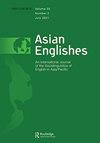The Hong Kong English accent continuum: insights from implicational scaling
IF 1.8
Q1 LINGUISTICS
引用次数: 1
Abstract
ABSTRACT The concept of the accent continuum is widely accepted in the study of new Englishes, yet relatively little is known about how distinctions such as educated versus broad accents are related to the presence or absence of accent features. This study applies the technique of implicational scaling to show how six key consonantal features are distributed across the HKE accent continuum. The basic principle is that the presence of certain features implies the presence of others, giving rise to clusters of features with regular patterns of co-occurrence. Using a standardised reading passage and a sample of 17 HKE speakers, the six features were found to follow such an implicational pattern in a statistically significant manner. The article discusses the possible explanations for these patterns, drawing on perspectives from second language acquisition and sociolinguistics, and concludes by considering the possible contributions of implicational scaling to the study of new Englishes.香港英语口音连续体:从含义尺度看
摘要在新英语研究中,重音连续体的概念被广泛接受,但人们对受过教育的口音和广泛的口音等区别与重音特征的存在或不存在之间的关系知之甚少。本研究应用隐含量表技术来展示六个关键的辅音特征是如何分布在HKE重音连续体中的。基本原理是,某些特征的存在意味着其他特征的存在,从而产生具有规则共现模式的特征集群。使用一篇标准化的阅读文章和17名讲英语的人的样本,发现这六个特征以统计学显著的方式遵循这种隐含模式。本文从第二语言习得和社会语言学的角度讨论了对这些模式的可能解释,并通过考虑隐含量表对新英语研究的可能贡献得出结论。
本文章由计算机程序翻译,如有差异,请以英文原文为准。
求助全文
约1分钟内获得全文
求助全文
来源期刊

Asian Englishes
LINGUISTICS-
CiteScore
3.30
自引率
18.80%
发文量
34
期刊介绍:
Asian Englishes seeks to publish the best papers dealing with various issues involved in the diffusion of English and its diversification in Asia and the Pacific. It aims to promote better understanding of the nature of English and the role which it plays in the linguistic repertoire of those who live and work in Asia, both intra- and internationally, and in spoken and written form. The journal particularly highlights such themes as: 1.Varieties of English in Asia – Including their divergence & convergence (phonetics, phonology, prosody, vocabulary, syntax, semantics, pragmatics, discourse, rhetoric) 2.ELT and English proficiency testing vis-a-vis English variation and international use of English 3.English as a language of international and intercultural communication in Asia 4.English-language journalism, literature, and other media 5.Social roles and functions of English in Asian countries 6.Multicultural English and mutual intelligibility 7.Language policy and language planning 8.Impact of English on other Asian languages 9.English-knowing bi- and multilingualism 10.English-medium education 11.Relevance of new paradigms, such as English as a Lingua Franca, to Asian contexts. 12.The depth of penetration, use in various domains, and future direction of English in (the development of) Asian Societies.
 求助内容:
求助内容: 应助结果提醒方式:
应助结果提醒方式:


